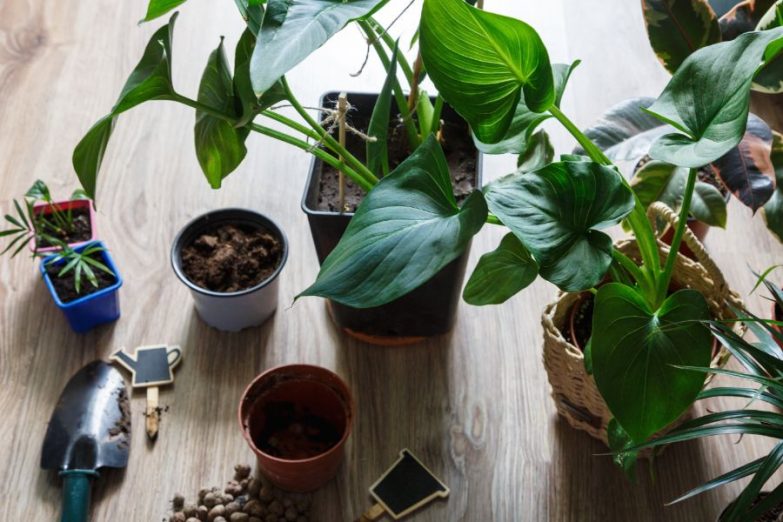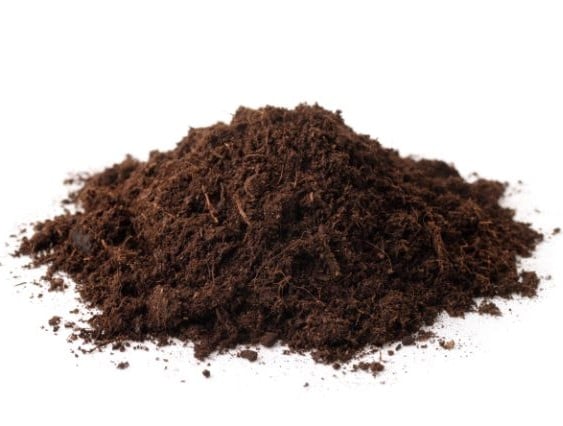Choosing potting soil for indoor plants is crucial to growing healthy houseplants. There are few things that make more difference to your success than understanding and creating a good soil environment for your plants. In this article, we’ll explain the basics of potting soil and show you how to find or create the ideal potting mix for your houseplants.
What makes the best potting soil for indoor plants? Plants don’t care about specific materials: they just need a medium with the right qualities. Roots need soil with enough structure to support the growing plant, and a mix that drains well while holding adequate moisture. Plants also need soil that provides aeration and nutrition at their preferred pH level.
The Best Potting Soil Isn’t Made Of Soil
Good potting mixes are lighter and fluffier than topsoil. They have special ingredients that work well for plants growing in containers.
The ideal potting soil for indoor plants varies because each plant’s original habitat determines its soil preference. Was it a sandy desert, a steaming swamp, or a heavily mulched forest floor? Some plants naturally grow in rock crevices or even perched in a tree.
Even though the exact makeup of a plant’s preferred mix varies, there are common elements. All houseplants require the following:
- Water – The medium must hold the right amount of moisture to nourish the plant between waterings.
- Air – There must be sufficient gas exchange for the roots to breathe.
- Fertility – The plant must be able to extract enough nutrition from the soil to live and grow.
- Anchoring – The soil must have enough structure to support the root system.
Plants thrive in whatever medium provides these needs, which explains the success of hydroponics.
Why You Shouldn’t Use Topsoil
One medium I don’t recommend is topsoil. It contains pathogens, bugs, and seeds – but the main problem is that outdoor soil is too heavy. It will suffocate plants in a container.
Since most potted plant deaths are from a lack of drainage and rotted roots, using “real” soil isn’t a good idea.
Getting Started – Types Of Potting Soil
Begin with a clear picture of the soil your plant needs. Here are the basic types:
All-Purpose Potting Mix
The classic potting soil for indoor plants holds moisture and drains well. It’s spongy and light with enough heft to form clumps that break apart easily. It can hold some moisture without becoming soggy and is fertile and fairly neutral in pH.
Succulent Mix
This potting soil drains even more quickly and holds less moisture. Typically containing sand or other coarse amendments, it has average fertility and is often slightly alkaline.
Epiphyte Mix
Orchids and other weak-rooted epiphytes need structure and aeration, and their preferred soil is typically infertile and acidic. Bark is often a major component.
Specialized Mixes
Individual soils for African violets, bromeliads, azaleas, evergreens, and even varieties within a species are available. Don’t be overwhelmed. These mixes can be convenient, but you can make your own custom soil as needed.
Potting Soil Ingredients
An ideal potting soil for indoor plants begins with soilless ingredients that provide structure, water retention, and aeration. Amendments for fertility are then added for a complete mix.
1. Soil Builders
Sphagnum
This natural plant material offers structure, aeration, and water-holding capacity. It’s lightweight and basically sterile … and slightly acidic.
Sphagnum decays slowly and tends to compact over time. Though not a major source of fertility, it offers a nice base for beneficial microorganisms. It’s typically mixed with fertile amendments.
Two forms of Sphagnum are sold for container gardening:
- Dried Sphagnum Moss – This is moss that has been harvested live and dried. It’s commonly sold with its long green, brown or gray fibers intact, such as seen in hanging baskets. It may also come chopped for easier mixing.
- Peat Moss – This is decayed sphagnum from natural peat bogs. It’s formed by a long process of decomposition, settling in layers as older moss dies and new living plants grow over the top.
Coconut Coir
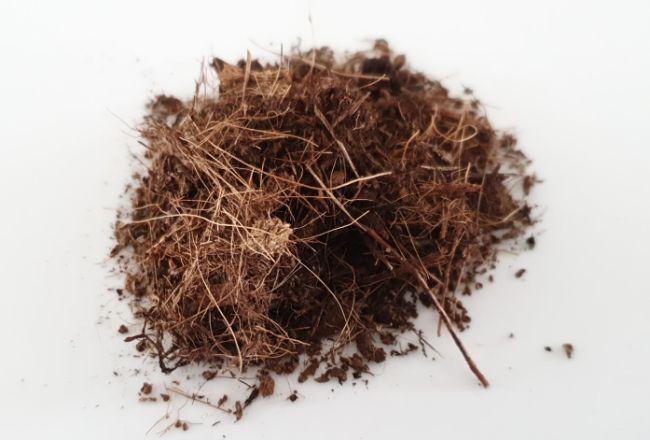
This natural material has become popular in recent years. Made of coconut husk fibers, it has even greater water-holding properties than peat moss. Coir has close to a neutral pH, so it’s less acidic than peat moss. It doesn’t compress either.
Coir is lightweight and easy to work with, though it’s infertile and lacks the microbial base of peat moss. It’s also high in potassium, which can interfere with calcium uptake in some plants.
Note: One downside to coco coir is that it may contain salt due to its harvest environment, so it’s a good idea to wash it before use.
Put coir in a bucket of water for five to seven days, changing the water and rinsing it daily. The coir will release brown tannins into the water that dissipate with the salt, which helps you know when it’s clean.
2. Aeration And Drainage Materials
Sphagnum and coco coir provide absorbency and structure, but plants also need air and drainage. These common amendments provide it:
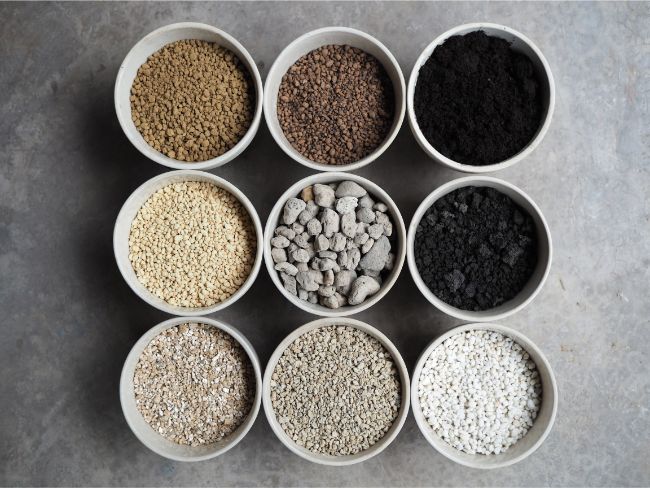
Perlite
This popular material is volcanic glass that’s been heated to the point it bursts into fragments. It’s naturally occurring, non-toxic, and reusable, though it does slowly decompose. It’s sterile and has a neutral pH.
The most important property of perlite is how well it aerates the mix. It’s a lightweight, insulating material that makes your soil more fluffy and airy. It doesn’t compress: perlite is often added to keep peat from compacting. Perlite has micro-pores that absorb some water and fertilizer to keep them available to the roots for longer periods.
One irritating characteristic of perlite is its tendency to float to the soil surface. This can make the potting mix look a little unusual and it has a tendency to escape from the pot when watering.
Pumice
Another porous volcanic leftover, pumice is a natural soil conditioner similar to perlite. It’s a little less annoying, because it’s heavy enough to stay in the soil instead of floating up.
Also called sponge rock, pumice is great for improving aeration and drainage. It doesn’t compact or decompose over time and so helps maintain soil stability. It’s pH neutral and, though nutritionally inert, it has irregular pores to which water and nutrients adhere.
Vermiculite
This processed mica is more water-absorbent than perlite or pumice, so it’s great for thirsty plants (or owners who don’t always remember to water). This property can keep the soil too wet for plants that like to dry out between waterings.
Vermiculite is pH neutral and doesn’t decompose. It’s lightweight and helps add aeration to the soil.
Sand
This is a traditional amendment for breaking up heavy soils. It’s inexpensive and reusable, but it has zero absorption capacity. It assists soil drainage, but you want to use coarse grains: small particles can actually reduce aeration.
Wood Chips
Fresh wood chips provide aeration and absorption capacity, but also decompose rapidly and use up soil nitrogen in the process. Pine is more desirable than hardwoods as it takes away less nitrogen.
Bark
Bark provides aeration, but it’s not absorbent: it contains wax that repels water to protect the tree. Bark doesn’t break down as quickly as wood, but it does use nitrogen as it decays and adds acidity to the soil.
Charcoal
Some gardeners put charcoal in the bottom of pots or mix it in the soil. This can reduce odors and provide limited aeration … but don’t take claims of toxin absorption and pest-control too seriously.
Calcined Clay
Calcined clay can improve soil drainage and absorbency. People sometimes confuse soil-grade calcined clay with kitty litter (another form of calcined clay), but it’s not. Calcined clay useful for potting mix is processed at higher heat to avoid becoming sludge when watered.
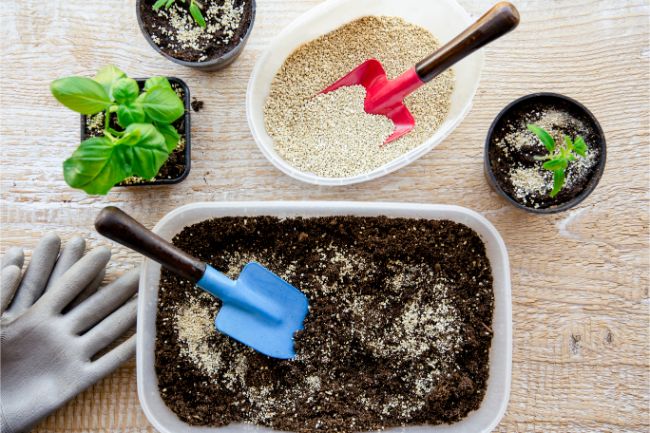
3. Fertility Amendments
So far we’ve discussed materials that provide well-draining soil with good absorbency, structure and aeration. Now we’ll finish with nutrients.
The three main elements your plants need in abundance are nitrogen, phosphorus and potassium. These ingredients are labeled on fertilizers with numbers called the NPK ratio. A balanced formula could be 10-10-10; a nitrogen-rich fertilizer may have an NPK ratio of 20-10-10.
In addition to these three nutrients, your plants need a lesser amount of calcium, magnesium, and sulfur, and an assortment of trace elements too.
Synthetic Fertilizers
Chemical fertilizers are water-soluble and supply quick nutrition to your plants. They’re usually cheaper and less complete than organics. They’re also more concentrated: it’s easy to apply the wrong amount and harm your plants.
Most retail mixes use inorganic fertilizers, and they can do a good job. If you’re making your own soil and want to use synthetics, you’ll typically want a balanced formula.
Organic Fertilizers
Organic amendments means a product made by or from animals or plants. It doesn’t mean organically grown – it’s not a certification.
Organic fertilizers are generally safe for your plants, and they truly excel at providing trace elements along with food for beneficial microbes. They’re usually more expensive than synthetics.
Compost
Compost is a traditional high-fertility amendment widely used in potting mixes. It’s a nutritious result of plant decomposition that naturally feeds your plants and conditions your soil, too.
Whether you buy ready-made compost or make your own, ensure it’s well decomposed. Mature compost smells sweet.
Worm Castings
Vermicast, or worm “poop,” has become more popular in recent years for good reasons. Worm castings offer incredible all-around nutrition along with a host of microorganisms and the trace ingredients plants thrive on.
Overall, worm castings are safe, odorless and mix easily in soil. The only downside is their cost.
Leaf mould
This organic additive is an excellent soil conditioner that promotes beneficial bacteria, though it doesn’t provide much fertility on its own. Crumbly, well-decomposed mould is suitable for potting and makes a fine mulch if not quite broken down.
Fish Emulsion
This quick-acting fertilizer made from fish works great and smells terrible. It helps feed soil microbes, too. It’s nitrogen-heavy and doesn’t offer the complete nutrition of worm castings. It’s safe but pricey: cheaper amendments can work just as well.
Manure
One organic material we can’t wholeheartedly recommend is manure. Since worm poop is so great, it seems logical to add other kinds of manure to the mix – it’s usually not. Horse, cow and chicken manures are acidic and have a lot of urea, making them too “hot” for safe use … plus they can contain seeds, herbicides and other contaminants.
Carefully aged and composted manure can be safe for plants, but they lose valuable nutrients in the process. Overall there are many variables with manure that can harm your container plants. Proceed with caution.
Going Old School
Soil amendments to boost fertility are nothing new, and you may wonder how advice from veteran gardeners translates to today. These venerable products still work:
Blood Meal
An inexpensive source of nitrogen that works well in compost: it’s thought to make compost’s nutrients easier to assimilate. It’s long-lasting and inexpensive.
Bonemeal
A longtime gardening staple, bonemeal adds a natural slow-release form of phosphorus.
Wood Ash
This venerable additive provides potassium and calcium and raises soil pH. Younger wood produces more nutrients. Charcoal is fine, but avoid ash from coal or treated lumber.
Pro Tip: A well-proven recipe is to combine one part blood meal, one part bone meal, and two parts ash.
Greensand
This potassium-rich product comes from the ocean bottom; you only need a couple of tablespoons per container. It sounds new-agey but has been used for centuries.
Kelp Meal
This additive provides potassium and a host of trace elements. Some swear by this amendment for clay soils.
So Many Others
There are many supplements that add soil fertility. Rock phosphate has its proponents for acid soils, for example, and there are a LOT of meal additives: cottonseed meal, alfalfa meal, soybean meal, feather meal, crab meal…
Variety is a wholesome practice, but there isn’t a magical amendment you have to have, no matter what the marketers say.
Choosing A Commercial Potting Soil For Indoor Plants
Retail potting soils can save time and effort, and some do a great job. Why hunt down a lot of ingredients when you can get them together in one bag?
The problem is you don’t know exactly what’s inside the mix. You can usually find an NPK ratio and the main ingredients, but not much about quality or sourcing. Commercial mixes can include additives for packaging and long-term storage, and they tend to be sterile without microbial life.
Another downside to commercial mixes is price. Cheap soil often contains topsoil and amendments that sound better than they grow plants. Good mixes can be expensive.
One practical solution is to start with a decent retail mix and add some quality amendments. You can supplement a light sphagnum mix, for example, and end up with a high-quality soil that has the ingredients you want without overspending.
What To Look For In A Potting Soil For Indoor Plants
You can go with a name brand, but you’ll pay extra for marketing. Be a little choosy, though: Cheap soil can be very expensive if everything you plant in it dies.
- The soil should be light and fluffy. Look for peat moss, perlite, vermiculite, and pine bark in the ingredients.
- Avoid mixes with topsoil.
- Some sand or Styrofoam can be okay, but soil with an abundance of either is suspicious.
- Be careful of potting soil for indoor plants containing roots, wood chips or colored materials. Many cheap mixes come from landfills or exhausted mulch.
- Most affordable commercial mixes use synthetic fertilizers. These can work, but check the NPK ratio. Some soils contain peat or other base without any fertilization. You can add it in; just know what you’re getting.
- Think twice about soils with “Starter” or “Slow-release” additives. They don’t last long, so you’ll soon need to fertilize anyway – yet it’s impossible to know when they expire. If you get one of these mixes, make sure it’s dry: moisture can pre-release the chemicals and burn roots.
- Think even more before purchasing a mix with water-retention gels or crystals. These cut down on watering – but you won’t know for how long. They probably won’t tide your plants over a long vacation as you may hope. They’re a wild-card that complicates plant care.
How to Make The Best Potting Soil For Indoor Plants
My ideal potting soil for indoor plants delivers top soil consistency, nutrition and pH. I won’t pretend it’s the only one out there. Every gardening book has its own recipe. Now that you know the basics, you can experiment with confidence.
Making your own mix can involve extra effort and possibly a little expense, but it’s easy and fun – and you’ll know exactly what’s in it. Your plants will love you for it.
Here it is:
60% Soil-Building Material
I suggest peat moss or coco coir for an ideal soilless structure that’s light and absorbent. Note: These materials come dry and compressed, so place them in a bowl of water until they expand. They can repel water when too dry.
40% Nutrients And Aeration Material
Perlite is my favorite material for adding drainage and keeping the soil airy and open. A potting soil for indoor plants containing 30% perlite will have excellent drainage and aeration and help to promote healthy roots and vibrant growth from your plants.
If you decide to use an organic fertilizing supplement, I recommend going with 10% worm castings. They’re easy to use, safe, odor-free and complete.
I prefer to use worm castings for outdoor potted plants, but use synthetic fertilizers for my houseplants. In this case, I simply make a 60/40 mix of peat moss and perlite for my houseplants that favor a general potting mix.
Many houseplants can be fussy about nutrient availability, and as long as I am careful to apply water soluble fertilizer in very dilute form, I find that I am better able to respond to my plants, rather than relying on less precise organic amendments.
You can change the ratio of peat moss to perlite for different plants. Some appreciate a bit more aeration, for example, or you may water less frequently and want more absorbency in the soil. Vegetables and other heavy feeders like high fertility.
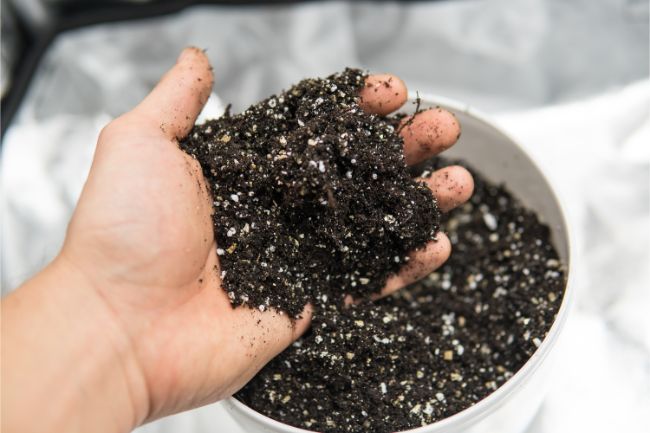
Succulent Mixes
Succulents like extra aeration and drainage. One easy method is to start with a retail mix that includes peat with bark and/or perlite – it doesn’t have to be expensive. Add drainage amendments like perlite, pumice, or even coarse sand, and a light amount of fertile amendments (they love organics).
Depending upon the succulent, you can go 50%-50% or even add more aeration material to get a faster-draining mix.
Epiphyte Mixes
Orchids, African violets, and other epiphytes like well-structured, highly aerated mediums. They don’t need a lot of fertility and do well with bark mixes. One part peat moss or coir to two parts of fir bark is a basic formula.
There isn’t one soil mix that suits all types: you’ll need to research your special potted baby. That’s part of the fun!
Substituting Materials
While it’s tough to beat peat moss and coco coir for building potting soil for indoor plants, you have a lot of choices for good aeration. You might want to use extra bark or coarse sand with your succulents or to add vermiculite for moisture-loving plants.
There’s even more options for fertility amendments, and this is where a variety of material helps most. You may want to go with easy worm castings, but old school supplements can work well, too. Just make sure there’s ample nitrogen, potassium and phosphorus, and don’t forget the trace elements.
Adjusting pH
Roots need the right soil pH to be able to absorb nutrients, so keeping the soil within your plant’s preferred range is important. Peat moss and other amendments can tilt the pH numbers, but test kits are inexpensive and adjustments are easy.
The basic rules are:
- Add lime to raise the pH
- Add sulfur to lower the pH
Ground limestone is a common amendment for adding lime; elemental sulfur is also widely available. Here’s an easy way to adjust your soil:
Raising pH
Add a teaspoon of lime per gallon of water and apply to the soil until it’s completely moistened. This usually raises the pH by about 0.5.
Lowering pH
Use a half-teaspoon of sulfur for every 6 inches of pot diameter. Spread granules on the soil or mix them with water and apply. This usually lowers the pH by about 0.5.
Wash off any solution that splashes on the plant to avoid burning it. Repeat in two weeks if the pH needs further adjustment.
Common Questions
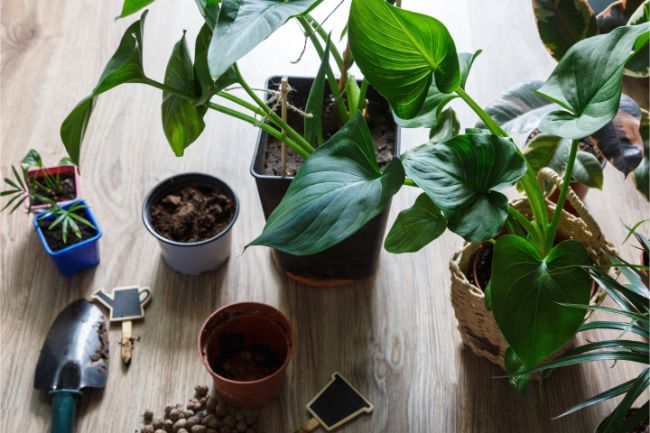
Should I Sterilize Soil Before Using It?
Some materials can carry pathogens, seeds, larva, etc., which may contaminate your plants. This isn’t normally an issue with commercial products, but it’s a good idea to treat compost, recycled soil, or other home-grown material.
You actually want to pasteurize your soil rather than sterilize it. Pasteurization uses a lower temperature than sterilization: it kills bugs and weeds and reduces disease pathogens without wiping out all the healthy microorganisms. (Overheating perlite can also release toxins.)
One simple pasteurization method is to spread soil on a baking pan and bake at 350°F for 45 minutes.
Pro Tip: You can microwave up to two pounds of soil. Microwave for 1-1/2 to 2/1/2 minutes. Use a thermometer to make sure the soil reaches 180°F (82°C).
Store the soil in an airtight container to prevent future contamination.
Can I Use 100% Organic Material To Grow Super-Healthy Plants?
No. Nutrients are just one aspect of healthy soil. Mixes made solely with organic material compact too much and will smother the roots. It also causes problems with water retention, and doesn’t provide a stable structure for strong root systems.
Is Peat Moss Bad For The Environment? What About Other Soil Components?
It’s not a simple yes of no answer with this one. Here are current controversies:
Peat Moss
Peat is a hot-button issue because it’s harvested from bogs worldwide and depletion is a concern. Bog renewal can take hundreds or even thousands of years, and irresponsible harvesting can destroy them completely.
However, the peat industry points out that a comparatively small amount of the world’s total peat is being harvested. Also, most peat moss available in the US comes from Canada, where peatlands are managed for long-term sustainability—there is actually more Canadian moss being grown than harvested each year.
Coco Coir
This controversy is about processing, not sustainability. Coir-making requires a lot of water and may cause environmental issues including soil depletion. It can contribute to respiratory problems for the low-wage labor that does the work (though processing does provide jobs). Some take issue with energy spent in transporting it overseas.
Perlite And Pumice
These volcanic products are not a renewable resource—at least not within a reasonable time period. There’s an abundance of the material, however: it is inexpensive and not currently in danger of depletion.
Vermiculite
This concern is about safety. Vermiculite can contain particles of asbestos, and so may products made with it. There have been health hazards and injury to miners in the past. It isn’t a major health risk to use, but it’s something to be aware of.
I’m running out of my old potting mix and want to switch to a new blend … should I use up the old stuff first?
The best way to change potting soil for indoor plants is to blend them together before using. If you’re replacing soil with a different blend, mix it with the older soil as much as possible: you don’t want to just top it off. Plants can be negatively impacted by different soil layers in one pot.

